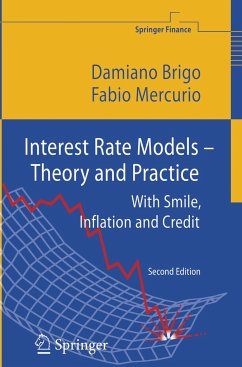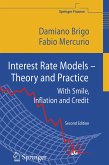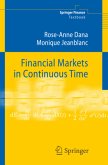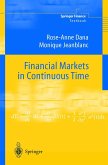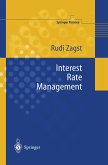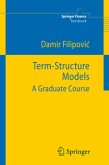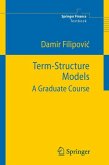The 2nd edition of this successful book has several new features. The calibration discussion of the basic LIBOR market model has been enriched considerably, with an analysis of the impact of the swaptions interpolation technique and of the exogenous instantaneous correlation on the calibration outputs. A discussion of historical estimation of the instantaneous correlation matrix and of rank reduction has been added, and a LIBOR-model consistent swaption-volatility interpolation technique has been introduced.
The old sections devoted to the smile issue in the LIBOR market model have been enlarged into several new chapters. New sections on local-volatility dynamics, and on stochastic volatility models have been added, with a thorough treatment of the recently developed uncertain-volatility approach. Examples of calibrations to real market data are now considered.
The fast-growing interest for hybrid products has led to new chapters. A special focus here is devoted to the pricing of inflation-linked derivatives.
The three final new chapters of this second edition are devoted to credit. Since Credit Derivatives are increasingly fundamental, and since in the reduced-form modeling framework much of the technique involved is analogous to interest-rate modeling, Credit Derivatives -- mostly Credit Default Swaps (CDS), CDS Options and Constant Maturity CDS - are discussed, building on the basic short rate-models and market models introduced earlier for the default-free market. Counterparty risk in interest rate payoff valuation is also considered, motivated by the recent Basel II framework developments.
The old sections devoted to the smile issue in the LIBOR market model have been enlarged into several new chapters. New sections on local-volatility dynamics, and on stochastic volatility models have been added, with a thorough treatment of the recently developed uncertain-volatility approach. Examples of calibrations to real market data are now considered.
The fast-growing interest for hybrid products has led to new chapters. A special focus here is devoted to the pricing of inflation-linked derivatives.
The three final new chapters of this second edition are devoted to credit. Since Credit Derivatives are increasingly fundamental, and since in the reduced-form modeling framework much of the technique involved is analogous to interest-rate modeling, Credit Derivatives -- mostly Credit Default Swaps (CDS), CDS Options and Constant Maturity CDS - are discussed, building on the basic short rate-models and market models introduced earlier for the default-free market. Counterparty risk in interest rate payoff valuation is also considered, motivated by the recent Basel II framework developments.
From the reviews of the second edition:
"The book 'Interest Rate Models - Theory and Practice' provides a wide overview of interest rate modeling in mathematical depth. ... The authors found a good approach to present a mathematically demanding area in a very clear, understandable way. The book will most likely become ... one of the standard references in the area. ... if one were to buy only one book about interest rate models, this would be it." (David Skovmand and Michael Verhofen, Financial Markets and Portfolio Management, Vol. 21 (1), 2007)
"This is the book on interest rate models and should proudly stand on the bookshelf of every quantitative finance practitioner and student involved with interest rate models. If you are looking for one reference on interest rate models then look no further as this text will provide you with excellent knowledge in theory and practice. ... is simply a must for all. Especially, I would recommend this to students ... . Overall, this is by far the best interest rate models book in the market." (Ita Cirovic Donev, MathDL, May, 2007)
"This is a very detailed course on interest rate models. Its main goal is to construct some kind of bridge between theory and practice in this field. From one side, the authors would like to help quantitative analysts and advanced traders handle interest-rate derivatives with a sound theoretical apparatus. ... Advanced undergraduate students, graduate students and researchers should benefit from reading this book and seeing how some sophisticated mathematics can be used in concrete financial problems." (Yuliya S. Mishura, Zentralblatt MATH, Vol. 1109 (11), 2007)
"The book 'Interest Rate Models - Theory and Practice' provides a wide overview of interest rate modeling in mathematical depth. ... The authors found a good approach to present a mathematically demanding area in a very clear, understandable way. The book will most likely become ... one of the standard references in the area. ... if one were to buy only one book about interest rate models, this would be it." (David Skovmand and Michael Verhofen, Financial Markets and Portfolio Management, Vol. 21 (1), 2007)
"This is the book on interest rate models and should proudly stand on the bookshelf of every quantitative finance practitioner and student involved with interest rate models. If you are looking for one reference on interest rate models then look no further as this text will provide you with excellent knowledge in theory and practice. ... is simply a must for all. Especially, I would recommend this to students ... . Overall, this is by far the best interest rate models book in the market." (Ita Cirovic Donev, MathDL, May, 2007)
"This is a very detailed course on interest rate models. Its main goal is to construct some kind of bridge between theory and practice in this field. From one side, the authors would like to help quantitative analysts and advanced traders handle interest-rate derivatives with a sound theoretical apparatus. ... Advanced undergraduate students, graduate students and researchers should benefit from reading this book and seeing how some sophisticated mathematics can be used in concrete financial problems." (Yuliya S. Mishura, Zentralblatt MATH, Vol. 1109 (11), 2007)

